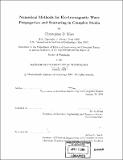| dc.contributor.advisor | Jin Au Kong. | en_US |
| dc.contributor.author | Moss, Christopher D. Q. (Christopher Doniert Q.), 1973- | en_US |
| dc.contributor.other | Massachusetts Institute of Technology. Dept. of Electrical Engineering and Computer Science. | en_US |
| dc.date.accessioned | 2005-09-06T20:46:28Z | |
| dc.date.available | 2005-09-06T20:46:28Z | |
| dc.date.copyright | 2004 | en_US |
| dc.date.issued | 2004 | en_US |
| dc.identifier.uri | http://hdl.handle.net/1721.1/26909 | |
| dc.description | Thesis (Ph. D.)--Massachusetts Institute of Technology, Dept. of Electrical Engineering and Computer Science, 2004. | en_US |
| dc.description | Vita. | en_US |
| dc.description | Includes bibliographical references (p. 227-242). | en_US |
| dc.description.abstract | Numerical methods are developed to study various applications in electromagnetic wave propagation and scattering. Analytical methods are used where possible to enhance the efficiency, accuracy, and applicability of the numerical methods. Electromagnetic induction (EMI) sensing is a popular technique to detect and discriminate buried unexploded ordnance (UXO). Time domain EMI sensing uses a transient primary magnetic field to induce currents within the UXO. These currents induce a secondary field that is measured and used to determine characteristics of the UXO. It is shown that the EMI response is difficult to calculate in early time when the skin depth is small. A new numerical method is developed to obtain an accurate and fast solution of the early time EMI response. The method is combined with the finite element method to provide the entire time domain response. The results are compared with analytical solutions and experimental data, and excellent agreement is obtained. A fast Method of Moments is presented to calculate electromagnetic wave scattering from layered one dimensional rough surfaces. To facilitate the solution, the Forward Backward method with Spectral Acceleration is applied. As an example, a dielectric layer on a perfect electric conductor surface is studied. First, the numerical results are compared with the analytical solution for layered flat surfaces to partly validate the formulation. Second, the accuracy, efficiency, and convergence of the method are studied for various rough surfaces and layer permittivities. The Finite Difference Time Domain (FDTD) method is used to study metamaterials exhibiting both negative permittivity and permeability in certain frequency bands. | en_US |
| dc.description.abstract | (cont.) The structure under study is the well-known periodic arrangement of rods and split-ring resonators, previously used in experimental setups. For the first time, the numerical results of this work show that fields propagating inside the metamaterial with a forward power direction exhibit a backward phase velocity and negative index of refraction. A new metamaterial design is presented that is less lossy than previous designs. The effects of numerical dispersion in the FDTD method are investigated for layered, anisotropic media. The numerical dispersion relation is derived for diagonally anisotropic media. The analysis is applied to minimize the numerical dispersion error of Huygens' plane wave sources in layered, uniaxial media. For usual discretization sizes, a typical reduction of the scattered field error on the order of 30 dB is demonstrated. The new FDTD method is then used to study the Angular Correlation Function (ACF) of the scattered fields from continuous random media with and without a target object present. The ACF is shown to be as much as 10 dB greater when a target object is present for situations where the target is undetectable by examination of the radar cross section only. | en_US |
| dc.description.statementofresponsibility | by Christopher D. Moss. | en_US |
| dc.format.extent | 245 p. | en_US |
| dc.format.extent | 12279892 bytes | |
| dc.format.extent | 12312169 bytes | |
| dc.format.mimetype | application/pdf | |
| dc.format.mimetype | application/pdf | |
| dc.language.iso | en_US | |
| dc.publisher | Massachusetts Institute of Technology | en_US |
| dc.rights | M.I.T. theses are protected by copyright. They may be viewed from this source for any purpose, but reproduction or distribution in any format is prohibited without written permission. See provided URL for inquiries about permission. | en_US |
| dc.rights.uri | http://dspace.mit.edu/handle/1721.1/7582 | |
| dc.subject | Electrical Engineering and Computer Science. | en_US |
| dc.title | Numerical methods for electromagnetic wave propagation and scattering in complex media | en_US |
| dc.type | Thesis | en_US |
| dc.description.degree | Ph.D. | en_US |
| dc.contributor.department | Massachusetts Institute of Technology. Department of Electrical Engineering and Computer Science | |
| dc.identifier.oclc | 55667095 | en_US |
